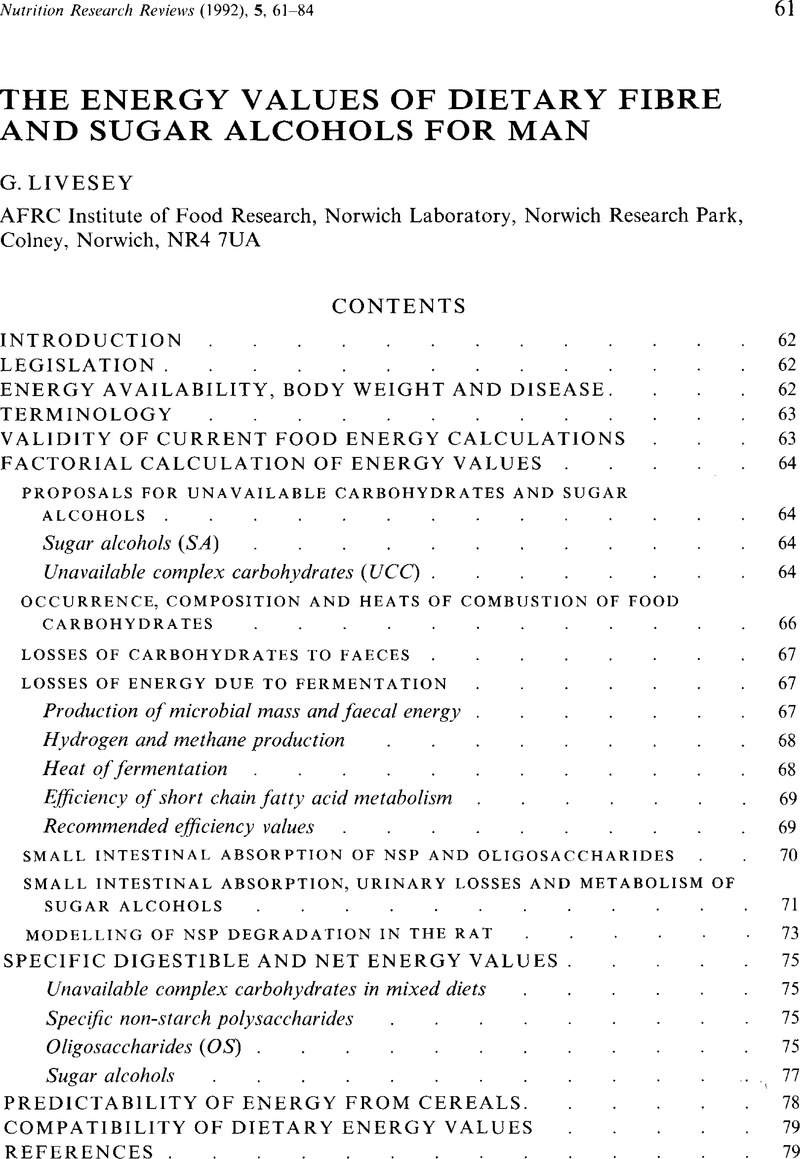Crossref Citations
This article has been cited by the following publications. This list is generated based on data provided by Crossref.
Livesey, Geoffrey
1993.
Comments on the methods used to determine the energy values of carbohydrates: Dietary fibre, sugar alcohols and other bulking agents.
International Journal of Food Sciences and Nutrition,
Vol. 44,
Issue. 4,
p.
221.
Livesey, G.
Schumann, Klaus
Elsenha, Bernd
Gordon, Dennis
and
Schlemmer, Ulrich
1994.
Letters to the Editors.
British Journal of Nutrition,
Vol. 72,
Issue. 6,
p.
947.
Moe, Paul W
1994.
Future Directions for Energy Requirements and Food Energy Values.
The Journal of Nutrition,
Vol. 124,
Issue. ,
p.
1738S.
Brown, Jacqueline C.
and
Livesey, Geoffrey
1994.
Urinary energy excretion in rats fed guar gum: Implications for putative thermogenesis.
Food Hydrocolloids,
Vol. 8,
Issue. 1,
p.
69.
Brown, JC
and
Livesey, G
1994.
Energy balance and expenditure while consuming guar gum at various fat intakes and ambient temperatures.
The American Journal of Clinical Nutrition,
Vol. 60,
Issue. 6,
p.
956.
Johnson, I. T.
and
Southgate, D. A. T.
1994.
Dietary Fibre and Related Substances.
p.
66.
Belsten, J. L.
Brown, J. C.
Holden, S.
Majsak-Newman, G.
Smith, T.
and
Livesey, G.
1994.
Hypocholesterolaemic non-starch polysaccharide from sugar beet.
International Journal of Food Sciences and Nutrition,
Vol. 45,
Issue. 1,
p.
49.
Livesey, G
1995.
Metabolizable energy of macronutrients.
The American Journal of Clinical Nutrition,
Vol. 62,
Issue. 5,
p.
1135S.
Wolever, T.M.S.
Radmard, R.
Chiasson, J.‐L.
Hunt, J.A.
Josse, R.G.
Palmason, C.
Rodger, N.W.
Ross, S.A.
Ryan, E.A.
and
Tan, M.H.
1995.
One‐year Acarbose Treatment Raises Fasting Serum Acetate in Diabetic Patients.
Diabetic Medicine,
Vol. 12,
Issue. 2,
p.
164.
Brunsgaard, Grete
and
Eggum, Bjørn O.
1995.
Small intestinal tissue structure and proliferation as influenced by adaptation period and indigestible polysaccharides.
Comparative Biochemistry and Physiology Part A: Physiology,
Vol. 112,
Issue. 3-4,
p.
365.
Ellwood, KC
1995.
Methods available to estimate the energy values of sugar alcohols.
The American Journal of Clinical Nutrition,
Vol. 62,
Issue. 5,
p.
1169S.
Storey, D. M.
and
Zumbe, A.
1995.
Handbook of Starch Hydrolysis Products and their Derivatives.
p.
178.
Zhao, Xinquan
Jørgensen, Henry
and
Eggum, Bjørn O.
1995.
The influence of dietary fibre on body composition, visceral organ weight, digestibility and energy balance in rats housed in different thermal environments.
British Journal of Nutrition,
Vol. 73,
Issue. 5,
p.
687.
Southgate, DA
1995.
Digestion and metabolism of sugars.
The American Journal of Clinical Nutrition,
Vol. 62,
Issue. 1,
p.
203S.
Livesey, G.
Smith, T.
Eggum, B. O.
Tetens, I. H.
Nyman, M.
Roberfroid, M.
Delzenne, N.
Schweizer, T. F.
and
Decombaz, J.
1995.
Determination of digestible energy values and fermentabilities of dietary fibre supplements: a European interlaboratory study in vivo.
British Journal of Nutrition,
Vol. 74,
Issue. 3,
p.
289.
Livesey, G.
and
Brown, J.C.
1995.
Whole Body Metabolism Is Not Restricted to D-Sugars because Energy Metabolism of L-Sugars Fits a Computational Model in Rats.
The Journal of Nutrition,
Vol. 125,
Issue. 12,
p.
3020.
Heijnen, Marie-Louise A.
Deurenberg, Paul
Amelsvoort, Johan M. M. Van
and
Beynen, Anton C.
1995.
Replacement of digestible by resistant starch lowers diet-induced thermogenesis in healthy men.
British Journal of Nutrition,
Vol. 73,
Issue. 3,
p.
423.
Ziesenitz, S. C.
1996.
Advances in Sweeteners.
p.
109.
Jørgensen, Henry
Zhao, Xin-Quan
and
Eggum, Bjørn O.
1996.
The influence of dietary fibre and environmental temoperature on the development of the gastrointestinal tract, digestibility, degree of fermentation in the hind-gut and energy metabolism in pigs.
British Journal of Nutrition,
Vol. 75,
Issue. 3,
p.
365.
Asp, N.-G
van Amelsvoort, J. M. M.
and
Hautvast, J. G. A. J.
1996.
Nutritional Implications Of Resistant Starch.
Nutrition Research Reviews,
Vol. 9,
Issue. 1,
p.
1.



